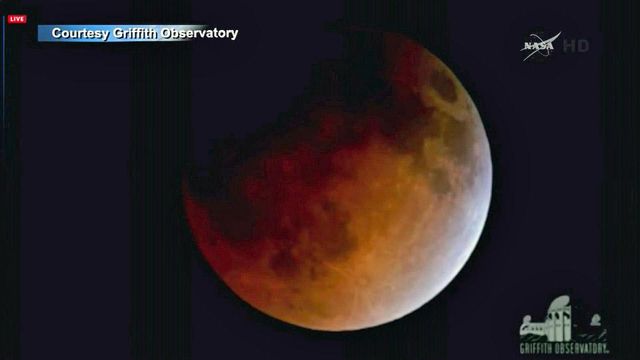Beginning of total lunar eclipse visible in Triangle early Saturday
The moon will turn amber red in the western sky before sunrise Saturday morning. This will be the shortest total lunar eclipse the century as the moon moves through the upper edge of the umbra, or darkest part of the Earth's shadow, for just 4 minutes 43 seconds.
Posted — UpdatedObservers west of the Mississippi River will see total eclipse, while those to the east will see a partial eclipse with moonset interrupting the show. Here in central North Carolina, your best view will be in an area with an unobstructed view of the western horizon. Even viewing from a second-floor window can help.
The eclipse starts at 6:15 a.m. when the moon is just 8º above the horizon. This may be below the tree line or behind a neighbor’s house unless you’ve found a good spot. Over the next 40 minutes, the moon will move deeper into that umbral shadow. By 6:55, it will be just above the horizon. The left half will be bathed in a coppery red light created as sunlight shines through the Earth’s atmosphere filtering out blue wavelengths. What we are seeing is essentially all sunrises and sunsets simultaneously projected onto the surface of the moon.
As the moon sets, the sun rises on the opposite horizon. About an hour later the total eclipse will begin but the moon will be well below the horizon for us here in Raleigh.
Our next total lunar eclipse on Sept. 27 will be visible here from start to finish. That one begins in primetime, 9:07 p.m., reaches maximum totality at 10:47 p.m., and finishes up by 12:27 a.m. Totality will last more than an hour the moon passes through much more of the Earth’s shadow.
This year’s pair of total lunar ellipses are the last ones visible from our area for a few years. Lunar eclipses in March 2016 and Feb. 2017 are penumbral ones, passing through the fainter Earth shadow making them difficult to tell much difference in.
Our next visible eclipse is one that many have had marked on their calendars for years, the total solar eclipse of Aug. 2017. Totality will be visible from the Oregon coast through the western tip of North Carolina and diagonally across South Carolina.
Should clouds spoil the view tomorrow morning, you can watch a live webcast of the event from the Griffith Observatory in Los Angeles or the Slooh Observatory. Clouds are expected to part in time for the 8:57 pass of the International Space Station from the southwest and again Sunday at 8:04 a.m. also from the southwest.
Copyright 2024 by Capitol Broadcasting Company. All rights reserved. This material may not be published, broadcast, rewritten or redistributed.





